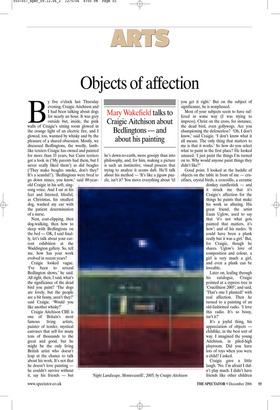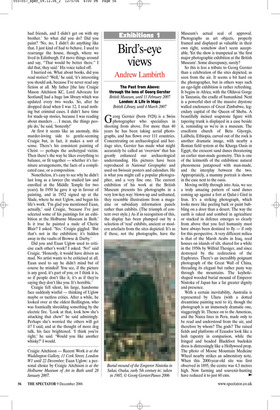Objects of affection
Mary Wakefield talks to Craigie Aitchison about Bedlingtons — and about his painting
By five o’clock last Thursday evening, Craigie Aitchison and I had been talking about dogs for nearly an hour. It was grey outside but, inside, the pink walls of Craigie’s sitting room glowed in the orange light of an electric fire, and I glowed, too, warmed by whisky and by the pleasure of a shared obsession. Mostly, we discussed Bedlingtons, the woolly, lamblike terriers Craigie has owned and painted for more than 35 years, but Cairn terriers got a look in (‘My parents had them, but I never really liked them’) as did beagles (‘They make beagles smoke, don’t they? It’s a scandal!’). ‘Bedlingtons were bred to go down mines, you know,’ said 80-yearold Craigie in his soft, singsong voice. And I sat at his feet and listened, blissful, as Christmas, his smallest dog, washed my ear with the patient determination of a nurse.
Next, coat-clipping, then dog-walking, then how to sleep with Bedlingtons on the bed — OK, I said finally, let’s talk about your current exhibition at the Waddington gallery. So, tell me, how has your work evolved in recent years?
Craigie looked vague. ‘I’ve been to several Bedlington shows,’ he said. All right, then, I said, what’s the significance of the dead bird you paint? ‘The dogs are lovely, but the people are a bit funny, aren’t they?’ said Craigie. ‘Would you like another whisky?’ Craigie Aitchison CBE is one of Britain’s most famous living artists, painter of tender, mystical canvases that sell for many tens of thousands to the great and good, but he might be the only living British artist who doesn’t leap at the chance to talk about his work. It’s not that he doesn’t love painting he couldn’t survive without it, say his friends — but he’s down-to-earth, more gossipy than into philosophy, and, for him, making a picture is such an instinctive, visual process that trying to analyse it seems daft. He’ll talk about his method — ‘It’s like a jigsaw puzzle, isn’t it? You move everything about ’til you get it right.’ But on the subject of significance, he is nonplussed.
Most of your subjects seem to have suffered in some way (I was trying to impress). Christ on the cross, for instance, the dead bird, even gollywogs. Are you championing the defenceless? ‘Oh, I don’t know,’ said Craigie. ‘I don’t know what it all means. The only thing that matters to me is that it works.’ So how do you select what to paint in the first place? He looked amazed. ‘I just paint the things I’m turned on to. Why would anyone paint things they didn’t like?’ Good point. I looked at the huddle of objects on the table in front of me — crucifixes, crystal birds, a crocodile, a ceramic donkey candlestick — and it struck me that it’s Craigie’s affection for the things he paints that make his work so alluring. His great friend, the artist Euan Uglow, used to say that ‘it’s not what gets painted that matters, it’s how’; and of his nudes: ‘It could have been a plank really but it was a girl.’ But, for Craigie, though he shares Uglow’s love of composition and colour, a girl is very much a girl, and even a plank can be loveable.
Later on, leafing through his catalogue, Craigie pointed at a cypress tree in ‘Crucifixion 2005’, and said, ‘That’s one I planted!’ with real affection. Then he turned to a painting of an old-fashioned radio. ‘I love this radio. It’s so bossy, isn’t it?’ It’s a joyful thing, his appreciation of objects childlike, in the best sort of way. I imagined the young Aitchison, in piled-high playroom. Did you have lots of toys when you were a child? I asked.
Craigie gave a little laugh. ‘No. I’m afraid I didn’t play much. I didn’t have friends like other children had friends, and I didn’t get on with my brother.’ So what did you do? Did you paint? ‘No, no, I didn’t do anything like that. I just kind of had to behave. I used to rearrange the house, though, where we lived in Edinburgh. I’d move things around and say, “That would be better there.” I did that, they said.’ His voice tailed off.
I hurried on. What about books, did you read stories? ‘Well,’ he said, ‘it’s interesting you should ask, because I’ve never read any fiction at all. My father [the late Craigie Mason Aitchison KC, Lord Advocate for Scotland] had a huge law library which was updated every two weeks. So, after he dropped dead when I was 12, I read nothing but criminal cases. I didn’t have time for made-up stories, because I was reading about murders ... I mean, the things people do,’ he said, ‘honestly!’ At first it seems like an anomaly, this murder-loving side to gentle-seeming Craigie but, in fact, it makes a sort of sense. There’s his consistent painting of Christ — perhaps the archetypal victim. Then there’s the way he likes everything to balance, or fit together — whether it’s furniture arrangements, the facts of a complicated case, or a composition.
Nonetheless, it’s easy to see why he didn’t last long as a lawyer (he studied law and enrolled at the Middle Temple for two years). In 1950 he gave it up in favour of painting, and in 1952 signed up at the Slade, where he met Uglow, and began his life’s work. ‘I’m glad you mentioned Euan, actually,’ said Craigie, ‘because I’ve just selected some of his paintings for an exhibition at the Holburne Museum in Bath.’ Is it true he painted a nude of Cherie Blair? I asked. ‘Yes.’ Craigie giggled. ‘But that’s not in the exhibition; it’s hidden away in the vaults of Browse & Darby.’ Did you and Euan Uglow used to criticise each other’s work? I asked. ‘No!’ said Craigie. ‘Honestly, it would have driven us mad. No artist wants to be criticised at all. Euan used to say he didn’t mind but of course he minded! You see, if the picture is any good, it’s part of you, or I think it is, so if people don’t like it, it’s as if they’re saying they don’t like you. It’s horrible.’ Craigie fell silent, his large, handsome face suddenly wistful — thinking of Uglow maybe or tactless critics. After a while, he looked over at the oldest Bedlington, who was frantically shredding something by the electric fire. ‘Look at that, look how she’s attacking that chew!’ he said admiringly. Perhaps she’s worried the others will get it? I said, and at the thought of more dog talk, his face brightened. ‘I think you’re right,’ he said. ‘Would you like another whisky?’ I would.
Craigie Aitchison — Recent Work is at the Waddington Gallery, 11 Cork Street, London W1 until 22 December; Euan Uglow: a personal choice by Craigie Aitchison is at the Holburne Museum of Art in Bath until 28 January 2007.



























































































 Previous page
Previous page